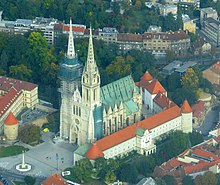Zagreb Cathedral
The cathedral of Zagreb ( Croatian Katedrala Uznesenja Blažene Djevice Marije i svetih Stjepana i Ladislava - "Cathedral of the Assumption of the Blessed Virgin Mary and Saint Stephen and Ladislaus ") in the Croatian capital Zagreb is one of the tallest buildings in Croatia with its two towers that can be seen from afar and a national treasure. It is the episcopal church of the Roman Catholic Archdiocese of Zagreb .
history
The earliest church on the site of the present cathedral is believed to be in the 10th century. The pre-Romanesque building was elevated to a cathedral when Ladislaus of Hungary founded the diocese in 1093. It was gradually replaced by a larger Romanesque cathedral, which was completed in 1217. This was the Tartar invasion in Dalmatia largely destroyed 1,242th From the end of the 13th century, including the Romanesque remains, the new cathedral was built in the Gothic style.
Work began in the east with the choir and the east nave - yokes , which were completed around 1300. In the second half of the 15th century, the western nave bays in the late Gothic style were probably completed by Prague builders. Thereafter, before the construction of towers could be tackled, the Ottoman expansion in southeastern Europe demanded all forces. The cathedral was surrounded by a mighty fortress with defense towers and gates, the structure of which, despite being converted into a baroque bishop's residence in the 18th century, can still be seen today; only the west wing in front of the tower facade was demolished at the end of the 19th century in order to create a spacious forecourt. In the 17th century, after the end of the Turkish threat, the cathedral got the early baroque bell tower on the south side of the portal facade, which shaped its appearance for 200 years. In the period that followed, the high baroque interior was created, which has largely been preserved.
Earthquakes damaged the cathedral several times in the course of its history. The quake of 1880 was so strong that the main nave and bell tower collapsed. Friedrich von Schmidt from Vienna and his student Hermann Bollé created the plans for the subsequent reconstruction in neo-Gothic forms . During this work, which lasted until 1902, the cathedral received two bell towers.
In the decades that followed, the cathedral suffered badly from the weather, air pollution and neglect during the communist era. The filigree building sculpture, especially on the tower facade, was largely lost. The southern tower was renovated from 1938 to 1941. An extensive renovation began in 1990 and is still ongoing today.
In June 2011 Pope Benedict XVI visited the cathedral and prayed at the shrine of Zagreb Archbishop and Cardinal Alojzije Stepinac (1898–1960), who was beatified in 1998 .
In a strong earthquake on March 22, 2020 , a 10.3 meter section of the southern spire with a 3.2 meter high gold-plated cross broke off. Parts of the rubble damaged the roof in the crash. Occasional damage was also caused to pinnacles , stained glass windows and the facade. In the vault , a crack formed. Damage was also found on the northern tower; on April 17, 2020, part of its top was removed using a crane due to the risk of collapse.
architecture
The nave of the cathedral still shows the two medieval construction phases: In the east, the polygonal choir is adjoined by two broad basilical yokes with half-height aisles. This is followed to the west by four narrower yokes, which approximate the type of hall church ; During the neo-Gothic renovation, they were given their own gables in the eaves. In front of it stands the representative neo-Gothic portal front with the two 105-meter-high towers, whose pointed hoods are made of perforated stone.
Furnishing
The rich furnishings come from the baroque of the 18th and the neo-Gothic of the 19th century. The treasury houses a valuable collection of liturgical implements and vestments, the oldest pieces of which date from the founding of the Zagreb diocese in the 11th century.
organ
The Walcker organ, which was built in 1855 with 52 stops on three manuals and pedal , is also important. After various modifications, it now has 78 stops and four manuals with the following disposition (as of 2005):
|
|
|
|
|
|||||||||||||||||||||||||||||||||||||||||||||||||||||||||||||||||||||||||||||||||||||||||||||||||||||||||||||||||||||||||||||||||||||||||||||||||||||||||||||||||||||||||||||||||||||||||||||||||||||||||||||||||||||||||||||||||||||||||||||||||||||||||||||||||||
-
Pairing :
- Normal coupling: II / I, III / I, III / II, IV / I, IV / II, IV / III, I / P, II / P, III / P, IV / P
- Super octave coupling: Super I, Super II / I, Super III / I, Super IV / I, Super IV / II, Super IV / III, Super I / P, Super II / P, Super III / P, Super IV / P
- Sub- octave coupling: Sub I, Sub II / I, Sub III / I, Sub IV / I, Sub IV / II, Sub IV / III,
- Playing aids : 999-fold general setter, 2-foldsplit setter, sequencer forwards and backwards, automatic pedal, crescendo , general reeds off, hand register off, reeds individually off, tutti, pleno, sill III, sill IV
- pneumatic cone chests with electro-pneumatic action control
Web links
Individual evidence
- ↑ Zagrebačka katedrala detaljno pregledana nakon potresa, evo što je sve oštećeno. In: n1info.com . April 2, 2020, accessed April 3, 2020 (Croatian).
- ↑ VIDEO: Croatian Army films historic removal of Zagreb Cathedral spire from the air. In: croatiaweek.com . April 18, 2020, accessed on April 19, 2020.
Coordinates: 45 ° 48 ′ 52 " N , 15 ° 58 ′ 47" E






